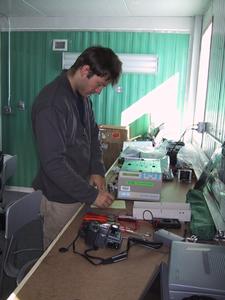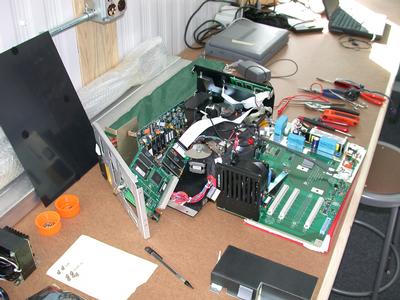
|
2 August, 2001You are only as good as the technology gremlins let you be. To all of you who had hoped to see a real audio broadcast today, apologies. The humans involved were all trying their hardest, but it seemed that the technology gremlins had different ideas for how this day would go. The problems with the gremlins started yesterday. I heard there were "worms" in the servers that allow us to do fancy things like real audio and the internet. Even the Server here at summit wasn't behaving. Last night as I was analyzing my melted snow samples the machine (high tech) that we depend on to tell concentration of (HCHO) is in the snow samples sputtered and then (for the second time this summer) the lamp died. Fortunately, for us here, Manuel Hutterli, our other partner from the University of Arizona, arrived yesterday afternoon with a box of new parts. In the days before he left the University, Manuel had been able to talk the manufacturer into overnighting him a new set of parts and electronics for the machine. (for about $2000.00) . It was a very good thing he and the new parts were here so that it could be repaired. This instrument measures HCHO in the snow samples. Without it functioning properly our work would be halted. This was in the nick of time! This morning I returned to low tech work while Manuel was busy repairing the machine. I continued my sampling of the snow and measuring the mass of the petri dishes. For those of you following the petri dish experiment, we are seeing results! (graph below) to learn more about this parallel experiments We have had some still, clear days and nights so that the mass of the dishes is making a nice sinusoidal curve. The dishes loose weight every day as the snow sublimates into the atmosphere. At night more frost ( moisture) is deposited onto the surface of the snow. This is called hoar frost. I am able to see this pattern by weighing the dishes four or five times a day. I also spent some low tech time tonight washing out the Schott bottles for more snow sampling tomorrow. Each bottle gets a triple wash before it is used again. I use between fourty and one hundred bottles a day. I will be here about thirty days in all, that multiplies to some 1600 sample bottles that I will wash, weigh, fill, weigh, melt, analyze, and wash again. Our server here at Summit camp has been up and down too... so we'll hope that in a few days the techno-gremlins will get tired and go hibernate! In the meantime, I am once again appreciative of the high -tech world but realize there's nothing like to old low-tech lifestyle which is much more controllable.
Contact the TEA in the field at . If you cannot connect through your browser, copy the TEA's e-mail address in the "To:" line of your favorite e-mail package. |






